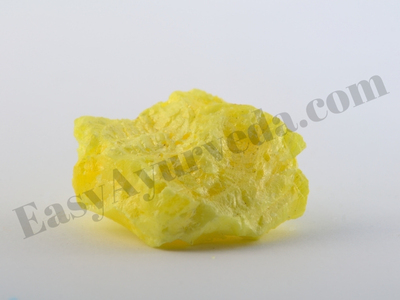Gandhaka: Synonyms, Types, Shodhana Dosage, Qualities
In the field of Rasayana, Gandhaka holds top position after the parade. Without the combination of Parada with gandhaka, most of the rasashastra compound formulation would not have been possible. The Gandhaka was known to scholars for ages. According to mythology, Gandhaka is considered as Raja of Godess Parvati.

Gandhaka is available in small quantities in pure form. In most of the mines, it is available in compound ore form with Iron, lead, copper, mercury, zinc etc. It is light, yellow coloured, and solid substance. It is opaque. It is available in rhombic and cubical shapes. It does not dissolve in water, but is soluble in Carbon disulphide, benzene and terpene. It is a good conductor of heat and electricity.
Table of Contents
Synonyms
Gandhashma, Rasagandhaka, Pamari, Sugandha, Putigandha, Lelitaka, Gouripushpa, Atigandha, balivasa, Keetaghna, Kushtari, Shulwari.
Availability
Gandhak in free form is available in Sicily volcano place, Spain, Texas, New Zealand, Japan etc.
The compound ore of Gandhaka is found in Russia, Japan, arna, Ireland, America, Chili Philippines, In India, it is available in Bihar, Rajasthan, Kumayu, Asam etc. places.
Types
There are 4 types.
- Raktavarna – red in colour- similar to peacock’s beak. – the best – used for Dhatuvada.
- Peetavarna – similar to peacock’s tail – medium qualities – for rasayana purpose
- Shuklavarna – similar to Sphatika – worst. For external applications.
- Krushnavarna – very rare – the best among all. To relieve from Jara and Mrutyu -. senility & death.
In practice, there are two types, in use.
- Amlasara Gandhak and
- Nainika Gandhaka – yellow in colour.
Suitable characteristics
Grahya Lakshana
शूकपिच्छसमच्छायो नवनीत समप्रभः ।
मसृणः कठिनः स्निग्धः श्रेष्ठॊ गन्धकः उच्यते ॥ (र.र.स)
śūkapicchasamacchāyo navanīta samaprabhaḥ |
masṛṇaḥ kaṭhinaḥ snigdhaḥ śreṣṭho gandhakaḥ ucyate || (ra.ra.sa)
The one having a colour similar to tail of the Peacock, (yellow), which is as soft to touch as butter, but hard inside, unctuous is considered as the best one.
Amlasara Gandhaka is used for internal administration. And Nainika Gandhaka is used for external purposes.
Harm due to consumption of impure Gandhaka:
अशुद्धगन्धः कुरुते च कुष्ठं तापं भ्रमं पित्तरुजं तथैव ।
रूपं सुखं वीर्यबलं निहन्ति तस्मादविशुद्धो विनियोजनीयः ॥ (आ.प्र)
aśuddhagandhaḥ kurute ca kuṣṭhaṃ tāpaṃ bhramaṃ pittarujaṃ tathaiva |
rūpaṃ sukhaṃ vīryabalaṃ nihanti tasmādaviśuddho viniyojanīyaḥ || (ā.pra)
Impure Gandhaka causes kushta,, increased body temperature, giddiness, pain due to excess pitta, and takes away beauty, health, and strength. It causes death.
Gandhaka Shodhana
- Gandhaka is melted with a little quantity of ghee and poured into the container with milk. The container with milk should be tied with a cloth, which acts as a filter. This process has to be repeated seven times.
- The above mentioned procedure can also be done with Bhringaraja swarasa, in place of milk.
- A pot with milk is taken. Cloth is tied over its mouth. Gandhaka coarse powder is spread over the cloth. Then, Gandhak is covered with a vessel and Sandhibandhana is done. [The mouth of the vessel and the pot are sealed]. The pot is placed in an earth pit. And heat is given from the upper side, with cow dung cakes. Gandhaka melts due to heat and gets collected in the pot containing the milk. All the sand and other waste particles thus get filtered out. Later the obtained Shuddha Gandhaka is washed with hot water and collected. If this process can be repeated upto 100 times, then Gandhak will be free from its peculiar smell.
Why the name “Balivasa”?
In mythology, King Bali used to consume Gandhaka to gain more strength. During the churning of the ocean, to obtain nector, the fat of king Bali liquefied and started oozing out. Ue to which Gandhak gained its peculiar smell. Hence the name Balivasa. It is also believed that Gandhaka got its toxic nature due to its interaction with the Vasuki snake’s poison during the churning of the ocean.
Dosage
1 – 8 Ratti (125 mg to 1 gram) per day in divided doses.
Qualities
Rasayana – rejuvenating,
Madhura rasa – sweet taste,
Katu vipaka – pungent post-digeation syate,
Ushna veerya – hot in potency
Useful in –
Kandu – itching,
Kushta – skin diseases,
Visarpa – herpes,
Dadru – ringworm.
Acts as Deepana, Pachana. It dries out Ama. It also acts as anti-toxic, useful in Pleeha, Adhma and Krumi.









